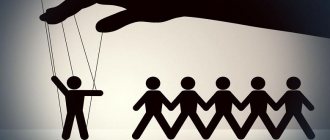The survivor's mistake is an unusual phenomenon, which we will tell you about in simple language right now. To accurately understand this phenomenon, we will give several textbook examples.
We recently published an article about cognitive distortions that are inherent in all people and, to one degree or another, affect us. If you haven’t read it yet, be sure to do so; it contains a lot of valuable information for lovers of psychology and self-development.
Survivorship bias is a type of selection bias in which there is a lot of data for one group (the survivors) and little to none for the other (the deceased).
As a result, researchers try to look for common features among the “survivors” and lose sight of equally important information that unites the “lost.”
This phenomenon has a much greater impact on us than it seems at first glance. A classic example of survivorship error occurred during World War II.
What is the survivor bug?
Survivor bias is a cognitive error in the perception of data when a person draws conclusions based only on the success of the “survivors” (those who succeeded) without taking into account the “lost” (those who did not achieve the same success). You can talk about this error in cases where two conditions are met:
- we draw conclusions based on data that describes the situation from only one side
; - we are not aware of this one-sidedness and are sure that we are looking at the whole picture
.
Simply put, survivorship bias is a type of selection bias where there is a lot of information on one group and little or no information on another.
The survivor effect is an interesting phenomenon that affects us more often than we think.
Due to the narrowness of the “sample” we come to completely wrong conclusions
and subsequently we don’t understand why everything went wrong. This description will become clearer when we look at the survivor's fallacy with a few examples.
Hungarian magician
This story will focus on the magician of statistics, the Hungarian mathematician Abraham Wald.
Abraham Wald
Realizing in time that Hungary was becoming one of the Axis (Nazi bloc) countries, Wald rushed to America and quickly got a job in the Statistical Research Group. The scientists gathered in this organization calculated various questions for the military: how many machine guns should be taken for one regiment, how to bomb the enemy more effectively - by targets or by the square-cluster method, how much corn one Marine eats per year... In a word, everything that can useful to the army.
The researchers worked in Manhattan, and often got their hands on the most secret data.
The security service seriously advised Abraham Wald not to read the reports he had written, but to immediately hand it over to his superiors and run away.
After all, he’s a defector from an enemy country, and a very smart one at that. If the security guards had been given free rein, they would have removed him from work altogether under a plausible pretext, but Abraham Wald was too important and necessary a person.
To solve the problems assigned to the group, he used the method of statistical sequential analysis. This tool, still used today in econometrics, consists of several successive samples and their observations, which ultimately make it possible to assess both the completeness of the sample and the accuracy of the decision made.
That is, with the help of complex formulas, not only is the problem solved, but it is also possible to determine how clearly and fully the conditions for its implementation were taken into account.
Survivorship Bias: A History
The first example is textbook
.
Actually, this is where the name of this phenomenon comes from. During World War II, mathematician and statistician Abraham Wald was tasked with determining which parts of bombers needed to be strengthened to increase their chance of returning to base when damaged.
After all, some ships arrived, even despite damage from the enemy, while others did not return after being hit. Wald analyzed the damage to the damaged aircraft that reached the base and found that most often the damage occurred in the tail, wings and some other parts of the fuselage. There were much fewer cars with damaged gas tanks and engines
.
It is logical to conclude that it is those parts that have more damage that need to be strengthened, isn’t it? Wald thought completely differently. Since among the returning aircraft there are few that had damaged engines and gas tanks, it means that such aircraft simply do not return to base
. Accordingly, to give them a chance, it is these parts that need to be strengthened.
Thus, if we draw conclusions only from data on survivors (returned aircraft, that is, from a partial sample that does not represent the entire situation), we will arrive at incorrect results. In turn, analysis of the whole picture radically changes the train of thought
.
This is survivorship bias. The main difficulty is that we cannot always understand in which cases we have complete data and in which we do not
. That is, this error can affect us, but we are not aware of it.
Stamp games[edit]
Documentary television[edit]
- In Australia and New Zealand, traffic police refuse to appear on television if the TV channel intends to show only the consequences of serious road accidents. According to police psychologists, this encourages viewers to break the rules. “The fool was racing through the 40 km/h limit at a speed of 120, so he crashed. But I don’t drive faster than the “hundred hundred” in such cases, nothing will happen to me!” It's more complicated here. In Austria, the fashion has spread to repeat the fate of Anna Karenina at one local railway station. The media, as they should, pressed tragic articles. Some people, having assessed the situation, saw that a considerable number of them are, so to speak... exalted youth, very prone to emotional breakdowns, easily addicted to fashion (including fashion for depression and other emo style). The authorities decided to conduct an experiment and asked the media NOT to write about such cases (or at least limit themselves to a short note on the last page). And real cases of “Anno-Karenism” have decreased. So the “monkey see, monkey do” effect should not be discounted. However, complete statistics for the country were not provided - perhaps these young people simply switched to using other locations and methods. So this is just great: a Darwin Award!
Comics[edit]
- 88.9% of Scott Adams' Dilbert comics play with the trope. “The HR department calculated that over the past year, exactly 40% of sick leave was taken by employees either immediately before or immediately after the weekend. Obviously, the employees were deceiving the company by extending their weekends.”[6]
How Survivor Bugs Work
Quite often we simply don’t think about the fact that we look at the situation one-sidedly.
. We automatically draw conclusions from “what is,” and this leads us to wrong decisions and judgments.
For example, there are many more articles in the media about plane crashes and medical errors
, than materials
that talk about successful landings and how doctors saved another life. Statistically, planes land in most cases, and doctors do not make mistakes in most cases, but it is not interesting to write about this, so journalists turn to negative stories much more often. In turn, because of this bias, some people have the wrong impression about medicine, flying, and much more
.
Let's give another example. Many are sure that all autistics communicate poorly and are not very adapted to independent life, but their brains work at the level of genius: they can multiply large numbers in their minds, know calendar dates for years ahead and back, etc. There are certainly such autistics, but not all of them fit the definition of “unsocialized geniuses.” People who have outstanding abilities in any field are called savants. However, not all savants are autistic and, accordingly, not all autistics are savants.
Why might a person not be happy about his salvation?
Survivor's guilt is a condition that can be experienced by a person who has survived a serious illness, disaster, accident, natural disaster, terrorist attack or combat. It would seem that we should be happy that we miraculously managed to escape. But instead we engage in self-flagellation and ask ourselves: “Why did others suffer? Why am I alive and is it deserved? Finding answers to these questions is impossible, and we are plunged into a destructive sense of guilt for being luckier than others. Especially if someone close to you was hurt.
“Five years ago I lost a friend,” says Dmitry. — We were traveling in a small group, I sat in the seat next to the driver. Then we stopped to take a break from the road and Max suggested we switch places. It didn’t matter to me, I agreed, and he sat in the front seat instead of me. And fifteen minutes after we set off, another car flew into us.
Max died on the spot, I escaped with a couple of bruises and a concussion, the other two guys also had minor injuries. The first time in the hospital I was in shock, and I refused to believe that this was really happening.
After a couple of days, the shock gave way to a feeling of guilt - after all, it was I who should have been sitting in that place. All the time I thought that I should have died instead of him. And perhaps I could have helped with something then, but I sat there as if I was paralyzed and did not know what to do. All these feelings only intensified, and every time I got into the car, the accident popped up in my head. After another severe panic attack, I went to see a therapist. Now I understand that no one could have predicted the disaster; many factors came together at the same time. And I still miss my friend very much.”
This is one example where survivor’s guilt is the result of a loss that has not been fully lived through. Typically, a grieving person goes through five stages of grief. Many researchers sound differently, but they are all based on the scheme proposed by Elisabeth Kübler-Ross: denial, anger, bargaining, depression and acceptance. And a person who feels guilty for his salvation seems to freeze in a state of anger and aggression, which he directs at himself.
Most often, survivor's guilt is a symptom of post-traumatic stress disorder, a severe mental condition. A person with PTSD tends to avoid situations that may remind them of the trauma, but at the same time, from time to time, they relive stressful events - through intrusive dreams, flashbacks, and analysis of the situation over and over again - and provoke feelings of guilt. PTSD also increases the risk of suicidal behavior.
In 2021, Sydney Aiello is a survivor of the Marjory Stoneman Douglas High School shooting. Then a student expelled from school killed 17 people, one of them was Sidney's close friend. A year later she committed suicide. The girl’s mother said that her daughter suffered from survivor’s guilt and was diagnosed with PTSD.
There is little research on survivor's guilt as a distinct syndrome, but it is a fairly common phenomenon—for example, occurring in 30–40% of war veterans. Among those who survived after industrial or transport accidents, 36–61% of people have this condition.
Survivor bias and success stories
Another important application of survivor bias is the currently popular success stories.
. Many fans of this genre are guided by the stories of their idols, dreaming of repeating their deeds and thus achieving success themselves. Of course, in such books, articles, trainings, etc. you can learn a lot of useful things.
You might be interested in other cognitive errors:
- fundamental attribution error (about why, in response to the same event, we tend to blame others and justify ourselves);
- Dunning–Kruger effect (about why less competent people consider themselves pros, while true professionals downplay their skills).
However, when turning to such sources, it is very important to remember: all success stories represent a group of survivors
(exactly as in Wald’s example), analysis of the actions of which is not enough to see the whole picture.
In fact, in addition to success stories, you need to study failure stories
in order to understand the most important mistakes that drowned some but helped others. And keep in mind that there are only a few success stories, while there are many stories of failures (even if we take a specific area of projects).










